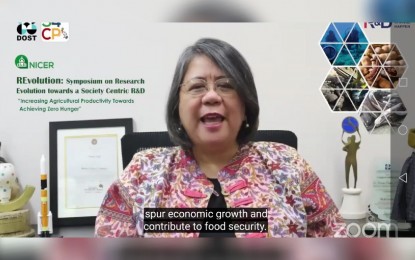
DOST Undersecretary Rowena Guevara (Screenshot from DOST-Science for Change Program's Facebook page)
MANILA – Among the focus of the Niche Centers in the Regions for R&D (research and development) or NICER will be on addressing hunger, and hopefully achieving zero hunger, officials of the Department of Science and Technology (DOST) said on Tuesday.
In a symposium, DOST Secretary Fortunato de la Peña said the government must invest in R&D to help end hunger and to strengthen the food system and activities that support regional development.
"We need to capacitate our regions to be ready for the challenges of the new environment," he said.
Launched in 2017, NICER aims to enable higher education institutions nationwide to make a significant improvement in regional research by integrating development needs with existing R&D capabilities and resources.
Establishing regional innovation hubs is among the DOST's key strategies towards developing a more science and technology-driven, sustainable, resilient, and progressive countryside, commented Undersecretary for Regional Operations Sancho Mabborang in the same symposium.
"I challenge these NICERs to take on the lead and steer the development of priority sectors through knowledge and technology generation, promotion, and transfer for the adoption of the target beneficiaries. We expect that NICERs will continue to expand their respective networks and build good relationships with the collaborators and stakeholders," Mabborang added.
In terms of contributing to inland aquatic resources, Undersecretary Rowena Guevara cited that Isabela State University has the Freshwater Fisheries Center.
"(The center) has established rearing facilities in 11 municipalities to grow ludong (lobed river mullet) and improved the culturing techniques of glass eels or igat which successfully increased their average weight by 204 percent and their average survival to 94 percent," Guevara said.
The official added that the rearing facilities generated employment for the Indigenous People, and also established the Cagayan Valley Aquaculture Producers Cooperative which led the community to venture into eel and freshwater fish production.
In the livestock industry, on the other hand, Guevara cited the Markaduke R&D Center, which is being hosted at the Marinduque State College.
This NICER has achieved improvement in the number of piglets weaned from 13 to as high as 18 pigs weaned per sow per year (PWSY). Its artificial insemination laboratory is equipped with a computer-assisted sperm analyzer to improve the reproductive efficiency of the male breeding pig.
The technology on feeding and husbandry practices are in line with the low-cost, low-input production system to be adaptable and practical under the household farming condition, Guevara said.
"In support of United Nations’ Sustainable Development Goals, the DOST, through these NICERs conducted R&D interventions to enhance agricultural yields in their regions to spur economic growth and contribute to food security," she said.
She said the DOST hopes that these NICERs' efforts to deliver scientific development to their community will encourage the private sector to conduct R&D projects aligned with their region’s economic priority.
"The DOST intends that these NICERs will produce and attract leading experts in their priority research area, the home of world-class equipment and facilities, and the central hub for R&D commercialization," she said. (PNA)
In a symposium, DOST Secretary Fortunato de la Peña said the government must invest in R&D to help end hunger and to strengthen the food system and activities that support regional development.
"We need to capacitate our regions to be ready for the challenges of the new environment," he said.
Launched in 2017, NICER aims to enable higher education institutions nationwide to make a significant improvement in regional research by integrating development needs with existing R&D capabilities and resources.
Establishing regional innovation hubs is among the DOST's key strategies towards developing a more science and technology-driven, sustainable, resilient, and progressive countryside, commented Undersecretary for Regional Operations Sancho Mabborang in the same symposium.
"I challenge these NICERs to take on the lead and steer the development of priority sectors through knowledge and technology generation, promotion, and transfer for the adoption of the target beneficiaries. We expect that NICERs will continue to expand their respective networks and build good relationships with the collaborators and stakeholders," Mabborang added.
In terms of contributing to inland aquatic resources, Undersecretary Rowena Guevara cited that Isabela State University has the Freshwater Fisheries Center.
"(The center) has established rearing facilities in 11 municipalities to grow ludong (lobed river mullet) and improved the culturing techniques of glass eels or igat which successfully increased their average weight by 204 percent and their average survival to 94 percent," Guevara said.
The official added that the rearing facilities generated employment for the Indigenous People, and also established the Cagayan Valley Aquaculture Producers Cooperative which led the community to venture into eel and freshwater fish production.
In the livestock industry, on the other hand, Guevara cited the Markaduke R&D Center, which is being hosted at the Marinduque State College.
This NICER has achieved improvement in the number of piglets weaned from 13 to as high as 18 pigs weaned per sow per year (PWSY). Its artificial insemination laboratory is equipped with a computer-assisted sperm analyzer to improve the reproductive efficiency of the male breeding pig.
The technology on feeding and husbandry practices are in line with the low-cost, low-input production system to be adaptable and practical under the household farming condition, Guevara said.
"In support of United Nations’ Sustainable Development Goals, the DOST, through these NICERs conducted R&D interventions to enhance agricultural yields in their regions to spur economic growth and contribute to food security," she said.
She said the DOST hopes that these NICERs' efforts to deliver scientific development to their community will encourage the private sector to conduct R&D projects aligned with their region’s economic priority.
"The DOST intends that these NICERs will produce and attract leading experts in their priority research area, the home of world-class equipment and facilities, and the central hub for R&D commercialization," she said. (PNA)
